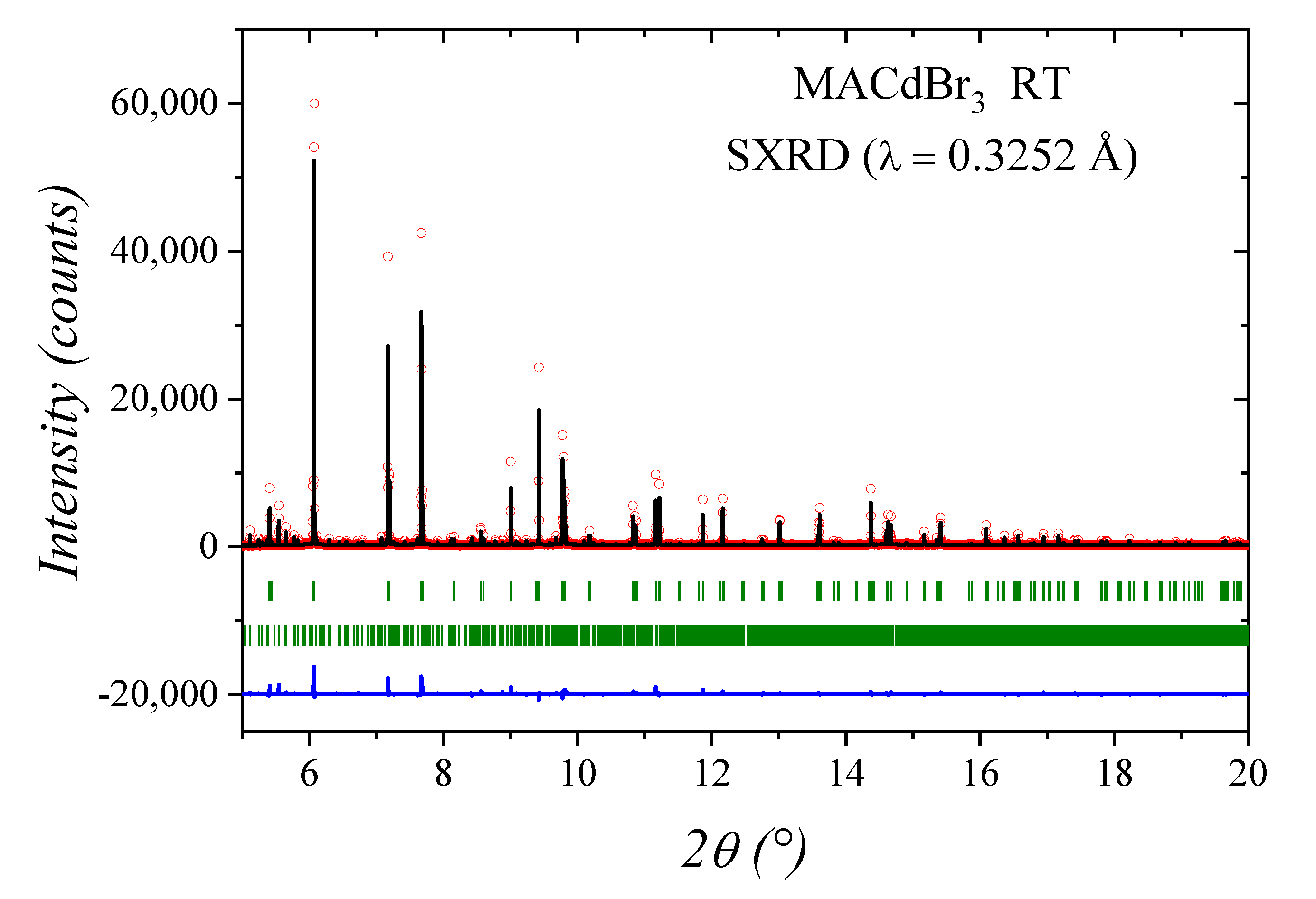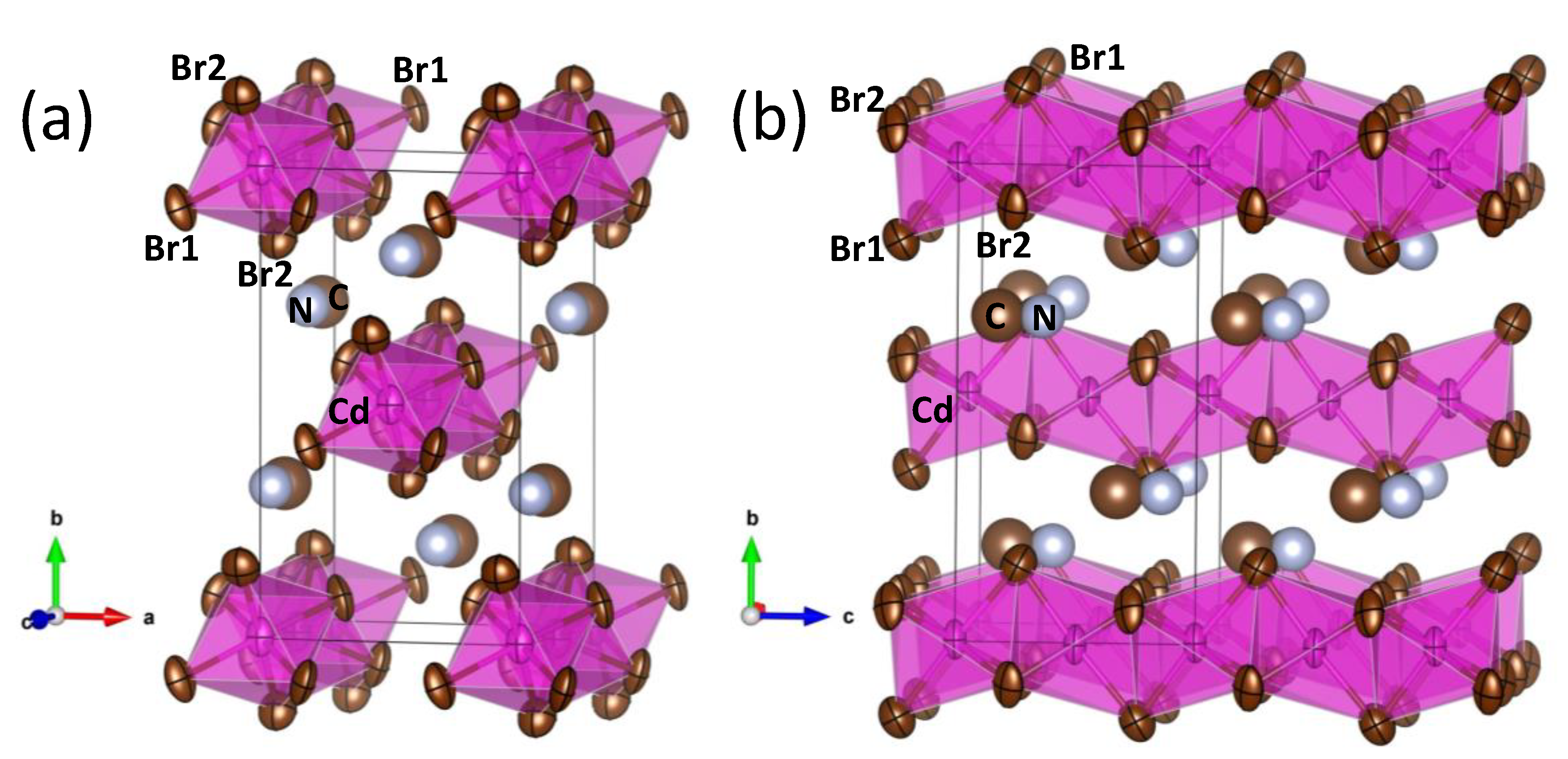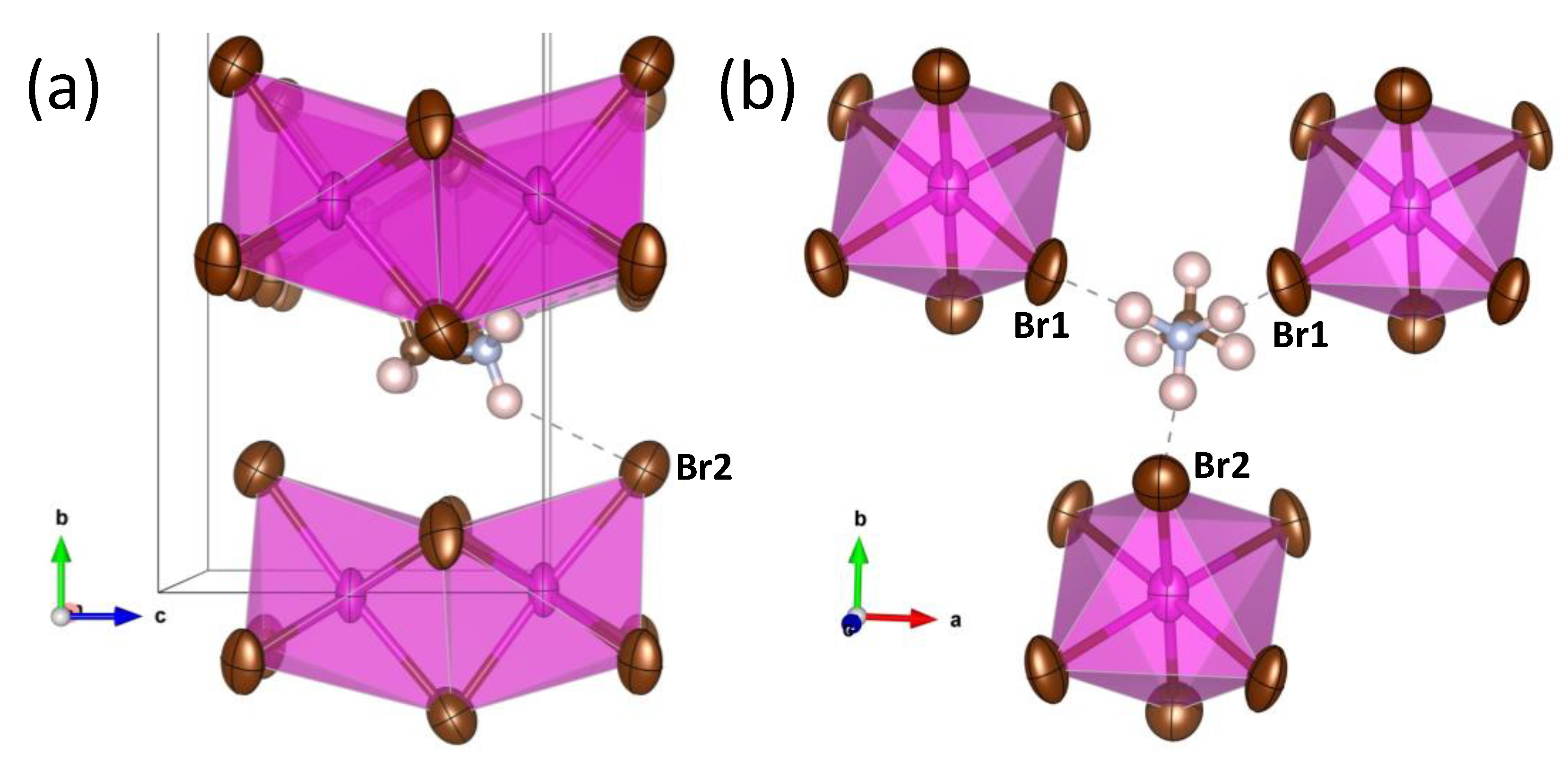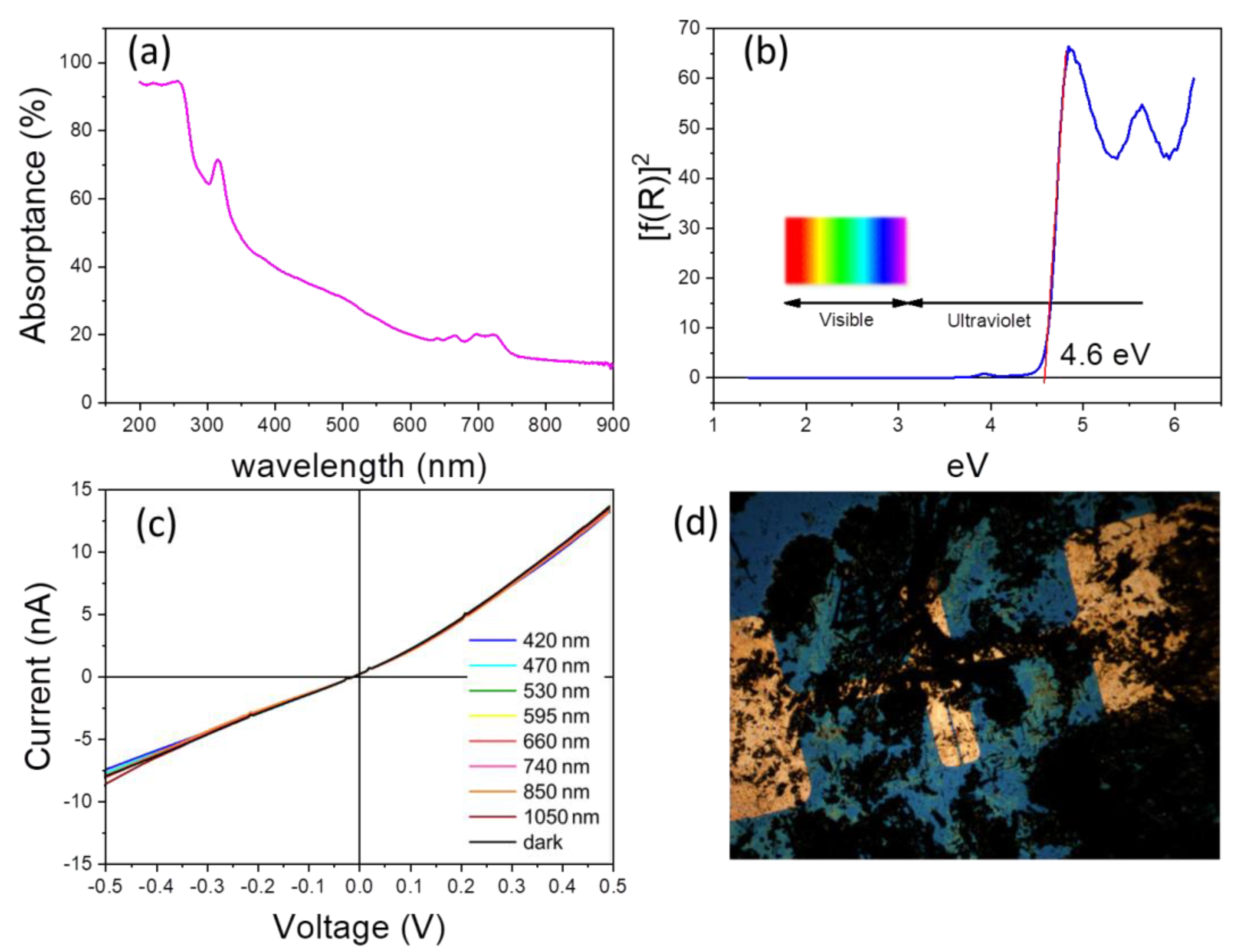Mechano-Chemical Synthesis, Structural Features and Optical Gap of Hybrid CH3NH3CdBr3 Perovskite
Abstract
1. Introduction
2. Materials and Methods
3. Results and Discussions
3.1. Initial Characterization: FE-SEM
3.2. Structural Characterization
3.3. Optical Gap by UV-Vis Spectra and Photocurrent Properties
4. Conclusions
Supplementary Materials
Author Contributions
Funding
Institutional Review Board Statement
Informed Consent Statement
Data Availability Statement
Acknowledgments
Conflicts of Interest
References
- Grätzel, M. The light and shade of perovskite solar cells. Nat. Mater. 2014, 13, 838–842. [Google Scholar] [CrossRef]
- Green, M.A.; Ho-Baillie, A.; Snaith, H. The emergence of perovskite solar cells. Nat. Photon 2014, 8, 506–514. [Google Scholar] [CrossRef]
- Snaith, H.J. Perovskites: The Emergence of a New Era for Low-Cost, High-Efficiency Solar Cells. J. Phys. Chem. Lett. 2013, 4, 3623–3630. [Google Scholar] [CrossRef]
- Park, N.-G. Organometal Perovskite Light Absorbers toward a 20% Efficiency Low-Cost Solid-State Mesoscopic Solar Cell. J. Phys. Chem. Lett. 2013, 4, 2423–2429. [Google Scholar] [CrossRef]
- Etgar, L.; Gao, P.; Xue, Z.; Peng, Q.; Chandiran, A.K.; Liu, B.; Nazeeruddin, K.; Grätzel, M. Mesoscopic CH3NH3PbI3/TiO2 Heterojunction Solar Cells. J. Am. Chem. Soc. 2012, 134, 17396–17399. [Google Scholar] [CrossRef] [PubMed]
- Kim, H.-S.; Lee, C.-R.; Im, J.-H.; Lee, K.-B.; Moehl, T.; Marchioro, A.; Moon, S.-J.; Humphry-Baker, R.; Yum, J.-H.; Moser, J.-E.; et al. Lead Iodide Perovskite Sensitized All-Solid-State Submicron Thin Film Mesoscopic Solar Cell with Efficiency Exceeding 9%. Sci. Rep. 2012, 2, 591. [Google Scholar] [CrossRef] [PubMed]
- Hsu, H.-Y.; Ji, L.; Ahn, H.S.; Zhao, J.; Yu, E.T.; Bard, A.J. A Liquid Junction Photoelectrochemical Solar Cell Based on p-Type MeNH3PbI3 Perovskite with 1.05 V Open-Circuit Photovoltage. J. Am. Chem. Soc. 2015, 137, 14758–14764. [Google Scholar] [CrossRef]
- Kojima, A.; Ikegami, M.; Teshima, K.; Miyasaka, T. Highly Luminescent Lead Bromide Perovskite Nanoparticles Synthesized with Porous Alumina Media. Chem. Lett. 2012, 41, 397–399. [Google Scholar] [CrossRef]
- Gao, P.; Grätzel, M.; Nazeeruddin, M.K. Organohalide lead perovskites for photovoltaic applications. Energy Environ. Sci. 2014, 7, 2448–2463. [Google Scholar] [CrossRef]
- Saparov, B.; Mitzi, D.B. Organic–Inorganic Perovskites: Structural Versatility for Functional Materials Design. Chem. Rev. 2016, 116, 4558–4596. [Google Scholar] [CrossRef] [PubMed]
- Zhang, M.; Yu, H.; Lyu, M.; Wang, Q.; Yun, J.-H.; Wang, L. Composition-dependent photoluminescence intensity and prolonged recombination lifetime of perovskite CH3NH3PbBr3−xClxfilms. Chem. Commun. 2014, 50, 11727–11730. [Google Scholar] [CrossRef]
- Alvarez-Galván, M.C.; Alonso, J.A.; López, C.A.; Lopez-Linares, E.; Contreras, C.; Lazaro, M.J.; Fauth, F.; Huerta, M.V.M. Crystal Growth, Structural Phase Transitions, and Optical Gap Evolution of CH3NH3Pb(Br1–xClx)3 Perovskites. Cryst. Growth Des. 2018, 19, 918–924. [Google Scholar] [CrossRef]
- Lopez, C.A.; Alvarez-Galvan, M.C.; Huerta, M.V.M.; Fernandez-Diaz, M.T.; Alonso, J.A. Dynamic Disorder Restriction of Methylammonium (MA) Groups in Chloride-Doped MAPbBr 3 Hybrid Perovskites: A Neutron Powder Diffraction Study. Chem. A Eur. J. 2019, 25, 4496–4500. [Google Scholar] [CrossRef]
- López, C.A.; Alvarez-Galván, M.C.; Martínez-Huerta, M.V.; Fauth, F.; Alonso, J.A. Crystal structure features of CH3NH3PbI3−xBrx hybrid perovskites prepared by ball milling: A route to more stable materials. CrystEngComm 2020, 22, 767–775. [Google Scholar] [CrossRef]
- Dirin, D.; Dreyfuss, S.; Bodnarchuk, M.; Nedelcu, G.; Papagiorgis, P.; Itskos, G.; Kovalenko, M.V. Lead Halide Perovskites and Other Metal Halide Complexes As Inorganic Capping Ligands for Colloidal Nanocrystals. J. Am. Chem. Soc. 2014, 136, 6550–6553. [Google Scholar] [CrossRef] [PubMed]
- Li, Y.; Yang, K. High-throughput computational design of organic–inorganic hybrid halide semiconductors beyond perovskites for optoelectronics. Energy Environ. Sci. 2019, 12, 2233–2243. [Google Scholar] [CrossRef]
- Koliogiorgos, A.; Baskoutas, S.; Galanakis, I. Electronic and gap properties of lead-free perfect and mixed hybrid halide perovskites: An ab-initio study. Comput. Mater. Sci. 2017, 138, 92–98. [Google Scholar] [CrossRef][Green Version]
- Kallel, A.; Mlik, Y.; Courseille, C.; Couzi, M. Structural phase transition in single-crystal CH3NH3CdBr3: I. Experimental studies. J. Phys. Condens. Matter 1992, 4, 7179–7190. [Google Scholar] [CrossRef]
- Ben Hassen, R.; Ben Salah, A.; Kallel, A.; Daoud, A.; Jaud, J. Crystal structure of monomethylammonium tribromocadmate(II). J. Chem. Crystallogr. 2002, 32, 427–430. [Google Scholar] [CrossRef]
- Vassilakopoulou, A.; Papadatos, D.; Koutselas, I. Polystyrene based perovskite light emitting diode. Appl. Mater. Today 2018, 12, 15–20. [Google Scholar] [CrossRef]
- Fauth, F.; Boer, R.; Gil-Ortiz, F.; Popescu, C.; Vallcorba, O.; Peral, I.; Fullà, D.; Benach, J.; Juanhuix, J. The crystallography stations at the Alba synchrotron. Eur. Phys. J. Plus 2015, 130, 160. [Google Scholar] [CrossRef]
- Rietveld, H.M. A profile refinement method for nuclear and magnetic structures. J. Appl. Crystallogr. 1969, 2, 65–71. [Google Scholar] [CrossRef]
- Rodríguez-Carvajal, J. Recent advances in magnetic structure determination by neutron powder diffraction. Phys. B Condens. Matter 1993, 192, 55–69. [Google Scholar] [CrossRef]
- López, C.A.; Abia, C.; Rodrigues, J.E.F.S.; Serrano-Sánchez, F.; Nemes, N.M.; Martinez, J.L.; Fernandez-Díaz, M.T.; Biškup, N.; Alvarez-Galván, C.; Carrascoso, F.; et al. Enhanced stability in CH3NH3PbI3 hybrid perovskite from mechano-chemical synthesis: Structural, microstructural and optoelectronic characterization. Sci. Rep. 2020, 10, 11228. [Google Scholar] [CrossRef] [PubMed]
- López, C.A.; Abia, C.; Alvarez-Galván, M.C.; Hong, B.-K.; Martínez-Huerta, M.V.; Serrano-Sánchez, F.; Carrascoso, F.; Castellanos-Gómez, A.; Fernández-Dıaz, M.T.; Alonso, J.A. Crystal Structure Features of CsPbBr3 Perovskite Prepared by Mechanochemical Synthesis. ACS Omega 2020, 5, 5931–5938. [Google Scholar] [CrossRef]
- Watthage, S. Solution-Processed Fabrication of Hybrid Organic-Inorganic Perovskites & Back Interface Engineering of Cadmium Telluride Solar Cells, University of Toledo. 2017. Available online: http://rave.ohiolink.edu/etdc/view?acc_num=toledo1512390043951256 (accessed on 10 June 2021).
- Khokhra, R.; Bharti, B.; Lee, H.-N.; Kumar, R. Visible and UV photo-detection in ZnO nanostructured thin films via simple tuning of solution method. Sci. Rep. 2017, 7, 1–14. [Google Scholar] [CrossRef]
- Yang, M.; Zhang, T.; Schulz, P.; Li, Z.; Li, G.; Kim, D.H.; Guo, N.; Berry, J.J.; Zhu, K.; Zhao, Y. Facile fabrication of large-grain CH3NH3PbI3−xBrx films for high-efficiency solar cells via CH3NH3Br-selective Ostwald ripening. Nat. Commun. 2016, 7, 12305. [Google Scholar] [CrossRef] [PubMed]
- López, C.A.; Martínez-Huerta, M.V.; Alvarez-Galván, M.C.; Kayser, P.; Gant, P.; Castellanos-Gomez, A.; Fernández-Díaz, M.T.; Fauth, F.; Alonso, J.A. Elucidating the Methylammonium (MA) Conformation in MAPbBr3 Perovskite with Application in Solar Cells. Inorg. Chem. 2017, 56, 14214–14219. [Google Scholar] [CrossRef]





| Atoms | Wyckoff Sites | x | y | z | Uiso*/Ueq | Occ |
|---|---|---|---|---|---|---|
| Cd | 4a | 0 | 0.0036(3) | 1 | 0.035(3) | 1 |
| Br1 | 8b | 0.2627(7) | 0.4199(6) | 0.248(3) | 0.051(5) | 1 |
| Br2 | 4a | 0 | 0.1612(7) | 0.262(2) | 0.056(9) | 1 |
| C | 4a | 0 | 0.32(1) | 0.67(2) | 0.12(1) * | 1 |
| N | 4a | 0 | 0.317(8) | 0.85(2) | 0.078(8) * | 1 |
| U11 | U22 | U33 | U12 | U13 | U23 | |
| Cd | 0.029(3) | 0.058(5) | 0.017(1) | 0 | 0 | −0.001(5) |
| Br1 | 0.034(4) | 0.082(6) | 0.038(6) | −0.018(3) | −0.012(3) | 0.002(5) |
| Br2 | 0.057(6) | 0.063(7) | 0.05(1) | 0 | 0 | 0.011(7) |
| Discrepancy factors: Rp: 8.46%; Rwp: 11.6%; χ2: 4.27; RBragg: 6.09%; MA2CdBr4: 16.7(2)%w/w | ||||||
| Present Structure | Hassen et al. [19] | |
|---|---|---|
| Cd–Br1 | 2.765 Å | 2.774 Å |
| Cd–Br1 | 2.787 Å | 2.783 Å |
| Cd–Br2 | 2.816 Å | 2.769 Å |
| Cd–Br2 | 2.792 Å | 2.786 Å |
Publisher’s Note: MDPI stays neutral with regard to jurisdictional claims in published maps and institutional affiliations. |
© 2021 by the authors. Licensee MDPI, Basel, Switzerland. This article is an open access article distributed under the terms and conditions of the Creative Commons Attribution (CC BY) license (https://creativecommons.org/licenses/by/4.0/).
Share and Cite
Alonso, J.A.; Kayser, P.; Hong, B.-K.; Álvarez-Galván, M.C.; Fauth, F.; Alberto López, C. Mechano-Chemical Synthesis, Structural Features and Optical Gap of Hybrid CH3NH3CdBr3 Perovskite. Materials 2021, 14, 6039. https://doi.org/10.3390/ma14206039
Alonso JA, Kayser P, Hong B-K, Álvarez-Galván MC, Fauth F, Alberto López C. Mechano-Chemical Synthesis, Structural Features and Optical Gap of Hybrid CH3NH3CdBr3 Perovskite. Materials. 2021; 14(20):6039. https://doi.org/10.3390/ma14206039
Chicago/Turabian StyleAlonso, José Antonio, Paula Kayser, Bo-Kyung Hong, María Consuelo Álvarez-Galván, Francois Fauth, and Carlos Alberto López. 2021. "Mechano-Chemical Synthesis, Structural Features and Optical Gap of Hybrid CH3NH3CdBr3 Perovskite" Materials 14, no. 20: 6039. https://doi.org/10.3390/ma14206039
APA StyleAlonso, J. A., Kayser, P., Hong, B.-K., Álvarez-Galván, M. C., Fauth, F., & Alberto López, C. (2021). Mechano-Chemical Synthesis, Structural Features and Optical Gap of Hybrid CH3NH3CdBr3 Perovskite. Materials, 14(20), 6039. https://doi.org/10.3390/ma14206039








